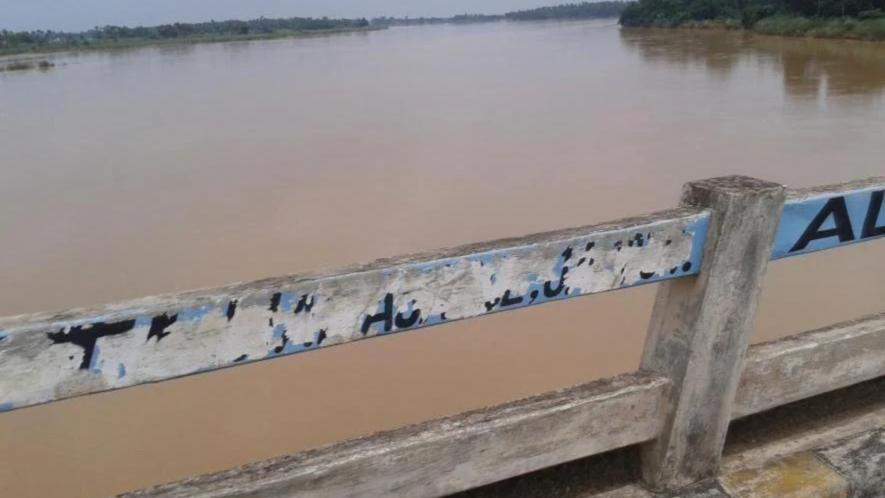Rivers Need Scientific Revival, Not Money and Cosmetic Changes

For the last decade, Prof Venkatesh Dutta, an environmental scientist, has been working to revive the Gomti river in Uttar Pradesh to improve its water quality and ecosystem. This has not been an easy task because the bureaucracy in Uttar Pradesh has failed to understand the basic principles of river management and revival. Successive political regimes have also focused more on appearances than scientific revival. Prof Dutta, who teaches at the School of Earth and Environmental Sciences at Ambedkar University, Lucknow, talks to Rashme Sehgal about these concerns. Significantly, he points out that the farmers have been far more receptive to scientific preservation of water sources, including the Gomti river, than the politicians or bureaucracy.
Why did reviving the Gomti become your focus?
When I went to Lucknow to teach environmental science, I was shocked to see the state of the Gomti. It was no better than a dirty drain. The first thought that came to my mind was, what can I do to revive this river with many special qualities? For one, it is fed entirely by groundwater and does not receive water from the melting snows of the Himalayas. The Gomti originates in the Pilibhit district of the Rohilkhand region of Uttar Pradesh and, after passing through 14 districts, merges with the Ganga at Ghazipur in eastern Uttar Pradesh. When I went to its point of origin in the Fulhaar jheel, a small water body, the river appeared very fragmented and heavily silted because its water was being diverted for farming. In 2011, I took out a River Yatra where my students, some retired engineers, some spiritual leaders and a few farmers travelled its length of 960 km to understand its physiology. We travelled by boat wherever the river was navigable, and in other areas, we walked or used different modes of transport.
What was the purpose of this yatra?
The idea was to involve as many people as possible in this yatra. We carried a mobile laboratory with us and kept testing the water quality. We also had a GPS that helped us locate many lesser-known rivers mentioned in the revenue records. The Gomti river had 28 tributaries, of which only a few are alive today. We are busy constructing roads and other infrastructure in their path, and in the process, we have lost all these rivers.
The river has 2,000 water bodies in the Gomti basin, which we are trying to revive. We prepared a report on the river’s health, which we submitted to then-chief minister Mayawati. She set up a River Restoration Committee headed by the chief secretary with members from the irrigation and other departments.
What was the experience like in terms of convincing governments to sign up?
The first problem we faced in trying to restore the flow of the river was dealing with the heavy encroachments that had taken place along its banks. The village lekhpals (patwaris) had sold land along the banks, and it was difficult to convince the district commissioners to cancel these leases. It was interesting that when the farmers understood the importance of a river having its embankments intact, they allowed us to map the land on both sides and were also willing to return this land.
When Akhilesh Yadav became the chief minister, the focus shifted from reviving the river to doing restoration work along the Gomti riverfront in Lucknow. The entire focus was Lucknow-centric, and the chief minister wanted a riverfront that compared to the River Thames in London and other European cities.
How did this shift in focus impact what you were trying to achieve?
The problem was that the chief minister wanted to follow the Sabarmati model, and all restoration became civil-engineering oriented. Over Rs 1,600 crore was spent on developing this riverfront without any prior Environment Impact Assessment. Subsequently, a probe was ordered (into how the money had been spent), and a few junior engineers were ‘framed’ and put behind bars.
The emphasis on river ecology was simply brushed aside. The government bureaucracy fails to understand that the river can cleanse itself in a matter of ten days. It can revitalise itself, and these are called flushing flows.
Could you explain the significance of this in the context of the Gomti river?
I prepared a 20-pointer for the government to emphasise the basic principles of ecosystem management. It is not easy to explain these basic principles to the bureaucracy because the government has created a system that survives on hype and ad hoc-ism. River management requires a long-term plan, and its only thumb rule is that river water must flow with life and the water must be drinkable.
There is a major parallel issue of non-functioning sewage treatment plants. Our rivers have become waste repositories, although we have spent crores on clean-ups and STPs. What explains this?
The State government has put up several Sewage Treatment Plants (STPs), which have a daily capacity to handle 450 million litres, but there is no one to check their efficiency. If the river water remains dirty even after the installation of STPs, the government needs to check their functioning. Why our rivers are unhealthy even after spending crores on STPs is because the government bodies have failed to create independent third-party audits of their functioning. The government needs to create a system based on evidence. When we check the dissolved oxygen levels and find that Biochemical Oxygen Demand (BOD) levels are zero, it is a clear indication that organic pollution levels remain very high, as in many parts of the river [Gomti].
What was the nature of the intervention that you and your team wanted to be made in the river?
We worked to revive the river’s fluvial terrace, meaning three times its width must be kept free from encroachments to ensure its free flow. We succeeded in releasing encroachments in some stretches of the river in Lakhimpur and Pilibhit, and we did this entirely with the help of the farmers. The government needs to put marking pillars to show how much land belongs to the river. This has been clearly demarcated in all the revenue records. The government machinery is willing to do this in a few places, but they do not have a long-term project. They need to work in mission mode.
How did you explain the importance of cleaning up the river embankments to the bureaucracy
We constantly interact with bureaucrats from the irrigation, minor irrigation, groundwater, horticulture, revenue and other departments. Sadly, government interventions remain cosmetic and expensive. The emphasis is to follow the ecological principles and science of restoration that allows a river its natural flow. This science is not money-centric. The government has set up many departments, but you don’t need a lot of money to implement these basic principles. In our report, we emphasise how the Gomti river basin recharges underground water tables before and after the monsoons, while its underground water table helps the river maintain its flow.
The Gomti river gets 76% of its water from the underground water table, called the ‘base flow index’. But the river’s flow has reduced over the years because the underground water sources have dried up. The river knows its catchment area. It needs surviving aquatic life because their presence is another indicator of the health of a river. We also need to stop industrial waste discharge in Sitapur, Gola Gokaran Nath and the upstream areas of the river. It is for the bureaucracy to come forward and understand the real requirements of this river.
The author is an independent journalist. The views are personal.
Get the latest reports & analysis with people's perspective on Protests, movements & deep analytical videos, discussions of the current affairs in your Telegram app. Subscribe to NewsClick's Telegram channel & get Real-Time updates on stories, as they get published on our website.

















